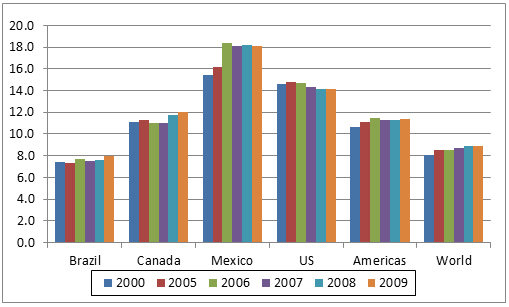



GLOBAL POULTRY TRENDS - More People in Americas Are Eating More Eggs
Average egg consumption in the Americas, at an estimated 11.4kg per person, is well above the global figure, writes industry watcher, Terry Evans in his analysis of the trends in egg consumption across the region. This average masks great variation from less than one kilo in some countries to more than 22kg in Mexico.Egg consumption per person is increasing virtually everywhere despite the growth in human population numbers. Globally, the average has risen from an estimated 8.1kg per person a year in 2000 to 8.9kg in 2008, holding steady at that level in 2009 (Table 1 and Figure 1).
In the same period, the average uptake in the Americas increased from an estimated 10.6kg to 11.4kg per person. These figures are best used as a guide to the trend, and too much attention should not be paid to the absolute levels and particularly to small changes from year to year. These figures are estimates of available supplies divided by estimates of the human population. There is considerable scope for error in the calculations around the estimates of layer numbers (especially when village or backyard flocks make a significant contribution to production), average yields, the average weight of an egg (where consumption is expressed in kilogrammes per person), coupled with the estimates of human populations. Additional problems arise when significant quantities of imported yolk or albumin as distinct from whole egg are utilised in food products. Indeed, the variation between the theoretical and actual quantities of eggs available for consumption could range from between five per cent and 20 per cent, depending on the reliability of the data used in the calculations.

Most importantly these figures should not be considered as reflecting changes in the demand for eggs. For most countries, the available supplies figure is broadly a measure of domestic production. When producers have incurred losses or foresee the likelihood of losses, production will be curtailed, which will be reflected in lower consumption per person, particularly since in most countries the human population will increase from one year to the next. Hence, movements up or down in production will normally be mirrored by similar changes in the number or weight of eggs consumed per person. Variations in demand are much more difficult to measure as such an assessment not only has to take account of changes in the quantities purchased but also how prices of eggs have moved over time. The calculation may also involve an assessment of the price movements and purchases of competitive products as well as changes in consumer incomes and preferences in order to give a clearer picture of why demand has changed.
Between 2000 and 2015, the global human population is forecast to rise by 1.2 billion (20 per cent) to about 7.3 billion (Table 1). For the Americas, the increase is expected to be around 147 million (18 per cent) to 982 million. As a result, this region looks as though it will just about hang on to its global share of around 13.5 per cent.
By 2015, the populations of the US, Brazil and Mexico will total 324 million, 203 million and 120 million, respectively, maintaining their two-thirds contribution to the regional total.
Based on the FAO data, global average egg consumption and that of the Americas increased by 0.8kg per person a year between 2000 and 2009 though, in both instances, there was little movement over the last three years of this period.
The differences in average consumption between countries is massive ranging from less than 1kg per person to more than 20kg per person, which points to enormous potential growth in the future for many countries in this region.
Although, according to FAO calculations, in 2009, Paraguay recorded the highest egg consumption per person at 19.5kg, it is now generally accepted that the population of Mexico eats the most eggs, the average quoted by the International Egg Commission for 2010 being 365 eggs per person. This did contract to 358 in 2011 which, at 62g per egg, would equate with an uptake of 22.2kg per person.
Uptake in the US declined dramatically since the record 311 eggs per person back in 1965 to 234 in 1990. Consumption then recovered to 255 in 2000. However, since then it has steadied at some 247 eggs per person. The number consumed in shell averages around 171, while an additional 76 are eaten in product forms. USDA long-term forecasts reveal that, although the total volume of eggs eaten in America will likely rise from 6.5 million dozen to almost 6.8 million dozen by 2021, because of population growth, on a per-capita basis, the average will decline further to around 239.
Recent years have witnessed an increase in uptake in Brazil from 125 eggs in 2009 to 134 per person in 2011. But, in contrast to the US where more than 30 per cent of eggs are eaten as products, the corresponding figures for Brazil are just eight eggs or six per cent!
In the recent past in many countries, the demand and consequently consumption of eggs has been hit by consumer concerns over the level of cholesterol in eggs. But, as it is now more generally accepted that, for most people, dietary cholesterol has little or no impact on blood cholesterol levels, their concerns in this area appear to be diminishing.
Higher production costs will have to filter through to consumer prices, which will impact negatively on egg consumption, particularly among the poorer sectors of communities. Economic recovery is therefore essential for increased sales to these consumers though, in the long-term, there is great scope for increased demand for eggs in many countries in the Americas. Among the more developed nations in this region, however, it appears that any increase will more than likely occur in the uptake of eggs in products rather than in shell.
January 2013












